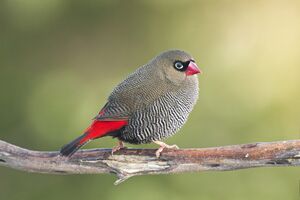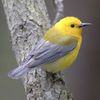العصفور البيوتي (زمرة)
| Passerea | |
|---|---|

| |
| Beautiful firetail (Stagonopleura bella) | |
| التصنيف العلمي | |
| أصنوفة غير معروفة (أصلحها): | Theropoda/skip |
| تحت صف: | حديثات الفك |
| الفرع الحيوي: | الطيور الجديدة |
| الفرع الحيوي: | العصفور البيوتي (زمرة) Jarvis et al., 2014 |
| Clades | |
Passerea is a clade of neoavian birds that was proposed by Jarvis et al. (2014).[2] Their genomic analysis recovered two major clades within Neoaves, Passerea and Columbea, and concluded that both clades appear to have many ecologically driven convergent traits.
According to Jarvis (2014), these convergences include the foot-propelled diving trait of grebes in Columbea with loons and cormorants in Passerea; the wading-feeding trait of flamingos in Columbea with ibises and egrets in Passerea; and pigeons and sandgrouse in Columbea with shorebirds (killdeer) in Passerea. For Jarvis (2014), these long-known trait and morphological alliances suggest that some of the traditional nongenomic trait classifications are based on polyphyletic assemblages.
Passerea was not recovered in other studies.[3][1]
Phylogeny
Cladogram of Passerea relationships based on Jarvis, E.D. et al. (2014)[2] with some clade names after Yuri, T. et al. (2013)[4] and Kimball et al. 2013.[5]
| Passerea |
| |||||||||||||||||||||||||||||||||||||||||||||||||||||||||||||||||||||||||||||||||||||||||||||||||||||||||||||||||||||||||||||||||||||||||||||||
The following cladogram illustrates the proposed relationships between bird clades of Passerea. This consensus phylogeny of birds is based on phylogenomic data, reflecting a recent phylogenomic supertree analysis[6] and modified after two recent more recent phylogenomic studies.[7][1]
المراجع
- ^ أ ب ت Kuhl, H.; Frankl-Vilches, C.; Bakker, A.; Mayr, G.; Nikolaus, G.; Boerno, S. T.; Klages, S.; Timmermann, B.; Gahr, M. (2020). "An unbiased molecular approach using 3'UTRs resolves the avian family-level tree of life". Molecular Biology and Evolution: 143. doi:10.1093/molbev/msaa191. PMC 7783168.
- ^ أ ب Jarvis, E. D.; Mirarab, S.; Aberer, A. J.; et al. (2014). "Whole-genome analyses resolve early branches in the tree of life of modern birds". Science. 346 (6215): 1320–1331. Bibcode:2014Sci...346.1320J. doi:10.1126/science.1253451. PMC 4405904. PMID 25504713.
- ^ Prum, R. O. et al. (2015) A comprehensive phylogeny of birds (Aves) using targeted next-generation DNA sequencing. Nature 526, 569–573.
- ^ Yuri, T.; et al. (2013). "Parsimony and Model-Based Analyses of Indels in Avian Nuclear Genes Reveal Congruent and Incongruent Phylogenetic Signals". Biology. 2 (1): 419–444. doi:10.3390/biology2010419. PMC 4009869. PMID 24832669.
{{cite journal}}: CS1 maint: unflagged free DOI (link) - ^ Kimball, R.T. et al. (2013) Identifying localized biases in large datasets: A case study using the Avian Tree of Life. Mol Phylogenet Evol. doi:10.1016/j.ympev.2013.05.029
- ^ Kimball, R.T.; Oliveros, C.H.; Wang, N.; White, N.D.; Barker, F.K.; Field, D.J.; Ksepka, D.T.; Chesser, R.T.; Moyle, R.G.; & Braun, M.J. (2019) A phylogenomic supertree of birds. Diversity 2019, 11, 109.
- ^ Braun, E.L. & Kimball, R.T. (2021) Data types and the phylogeny of Neoaves. Birds, 2(1), 1-22; https://doi.org/10.3390/birds2010001
- ^ Boyd, John (2007). "NEORNITHES: 46 Orders" (PDF). John Boyd's website. Retrieved 30 December 2017.














